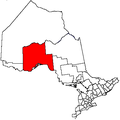world.wikisort.org - Canada
Gull Bay First Nation or Kiashke Zaaging Anishinaabek (Gayaashki-zaagiing Anishinaabeg in the Fiero orthography) is an Anishinaabe (Ojibway) First Nation band government located in Thunder Bay District in northwestern Ontario, Canada. It is approximately 175 kilometres (109 mi) north of Thunder Bay, Ontario on Highway 527 on the western shore of Lake Nipigon. As of May 2010, the First Nation had a registered population of 1,149 people, including an on-Reserve population of 328.
Gull River 55
Kiashke Zaaging | |
|---|---|
Indian reserve | |
| Gull River Indian Reserve No. 55 | |
 | |
 Gull River 55 | |
| Coordinates: 49°49′N 89°06′W | |
| Country | |
| Province | |
| District | Thunder Bay |
| First Nation | Gull Bay |
| Area | |
| • Land | 41.69 km2 (16.10 sq mi) |
| Population (2011)[1] | |
| • Total | 210 |
| • Density | 5.0/km2 (13/sq mi) |
| Time zone | UTC-5 (EST) |
| • Summer (DST) | UTC-4 (EDT) |
Governance
The Chief and 10 Band Council members elected every 4 years under the First Nations Elections Act Electoral system.[2] Before 2012, the council had 11 members but it was narrowed down to ten council members, with the passing of a council member. The current Chief is Wilfred King, whose first term began on January 12, 2013 (at the time, it was a 2-year term). The current councillors are Anthony Esquega, Brian King, Gwendoline King, Hugh King, Kenny King, Kevin King, Wayne King, Hector Murchinson, Roland Poile, Lawrence Shonias Sr, and Marcel Shonias. The next election will take place in November 2020.
As a signatory to the Robinson Superior Treaty of 1850, Kiashke Zaaging Anishinaabek is a member of the Nokiiwin Tribal Council, a Regional Chiefs Council, and the Union of Ontario Indians, a Political Territorial Organization that represents many of the Anishinaabe First Nation governments in Ontario located about Lake Superior and Lake Huron.
In August 2019, the community shut down its diesel electric generator for the first time in 60 years, drawing power from a new solar panel installation. Diesel is still used overnight.[3]
List of Chiefs
- Wilfred King (December 14, 2000 to December 10, 2022)
- Miles Nowegejick (December 10, 2010 to January 12, 2013)
- Wilfred King (January 12, 2013 to present)
Reserve
The Gull Bay First Nation has reserved for itself the 3,940 hectares (9,700 acres) Gull River 55 Indian Reserve. The community of Gull Bay is located on this reserve.
Land claims
Reserve size
The First nations signatories of the Robinson Superior Treaty were unfamiliar with the unit of the mile, and assumed it was the size of a league. The treaty gave each band a reserve of 16 square miles, which was much smaller than what the signatories expected. As soon as the error was noticed, the first nations notified the crown of the issue, and surveyors corrected the problem except for a few reserves, such as the Gull Bay First Nation, considered too far and too remote. The Gull Bay first nation filed a claim with the government of Canada on the issue of the size of their reserve in 2016.[4]
Timber rights
In 2016, the band voted to accept a 8.1 million dollar settlement from the government over timber royalties on the reserve.[5]
References
- "Gull River 55 census profile". 2011 Census of Population. Statistics Canada. 8 February 2012. Retrieved 28 May 2015.
- "Gull Bay First Nation, Government Office, Governance". search.211north.ca. Retrieved 2018-09-07.
- "Canadian first: After decades of diesel, solar power comes to remote community".
- "Gull Bay First Nation files claim to fix 166-year-old error in size of reserve | CBC News". CBC. 1 March 2016. Retrieved 2019-03-04.
- "Gull Bay to vote on $8 million settlement". TBNewsWatch.com. Retrieved 2019-03-04.
Другой контент может иметь иную лицензию. Перед использованием материалов сайта WikiSort.org внимательно изучите правила лицензирования конкретных элементов наполнения сайта.
WikiSort.org - проект по пересортировке и дополнению контента Википедии
